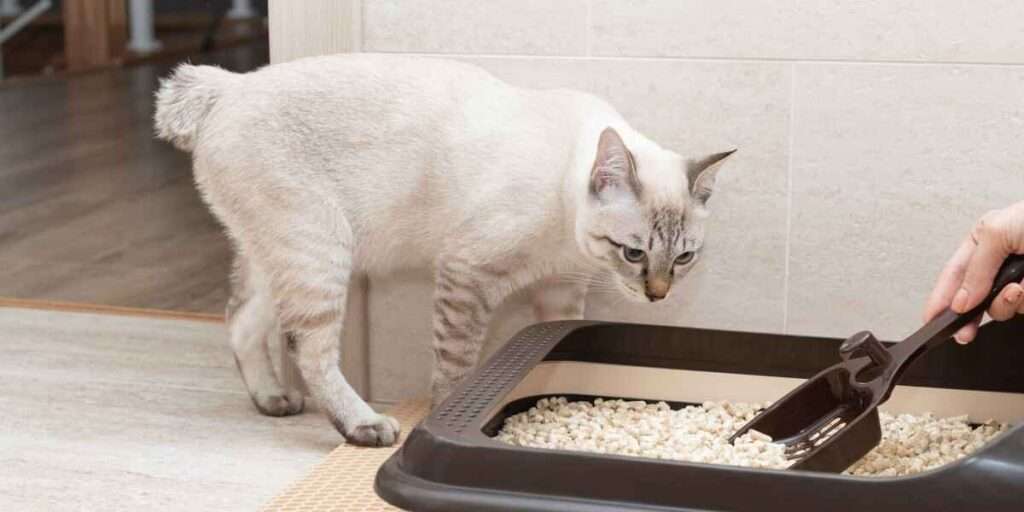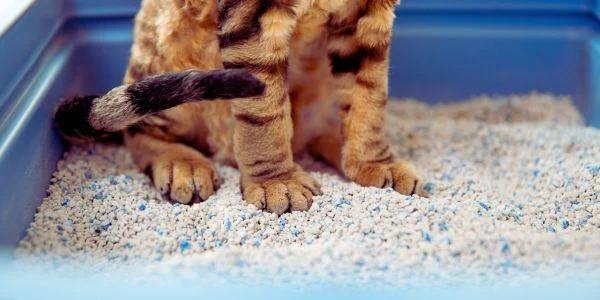Cats are cherished pets, and ensuring they have a clean, hygienic space to eliminate is crucial for their health and the cleanliness of your home. This is where cat litter plays a crucial role; it is a vital tool for every cat owner.
Learn more about: Can cats eat grapes
Whether you are new to cat ownership or looking to improve your cat’s litter environment, this detailed guide offers all the information you need. It covers the types of cat litter, their benefits, how to select the best one for your cat, and how to keep the litter box in good condition.

What Is Cat Litter?
Cat litter is a material placed in a litter box to absorb urine and cover cat feces. It helps manage odors, keeps the box cleaner, and makes it easier to dispose of waste.
In the past, cats used natural items like sand, dirt, or shredded paper. Today, cat litter is made from a variety of materials, including clay, silica, natural fibers, and more, each with its advantages.
What Makes Selecting the Right Cat Litter So Important?
Selecting the right litter plays a big role in keeping your cat comfortable and your home clean. If the litter is not suitable, your cat might refuse to use the box, which can result in messes and unnecessary stress.
Different cats have different preferences.
Some like fine-grained, low-dust litters, while others may tolerate coarser textures better.
Types of Cat Litter
- Clay-Based Litter: Clumping Clay Litter, this variety, made with bentonite clay, absorbs moisture and forms solid clumps, making daily cleaning more convenient.
- Non-Clumping Clay Litter: This absorbs moisture but doesn’t clump, requiring more frequent complete cleanings.
- Silica Gel Litter: This type is made of tiny crystals that effectively absorb moisture and control odors with very little dust.
- Natural and Biodegradable Litter: These litters are made from materials like corn, wheat, pine, walnut shells, or paper. They are eco-friendly and often produce less dust.
- Wood-Based Litter: This type uses wood pellets or shavings. It offers a natural scent and good odor control, but it is not as common.
How to Find the Right Cat Litter for Your Furry Companion
Consider Your Cat’s Preferences. Observe how your cat reacts to different litter types. Some may dislike scented litters or those that are too dusty.
Think About Odor Control
If managing odor is a priority, clumping clay or silica-based litters tend to be more effective at controlling smells.
Look for Low Dust and Low Tracking
Dusty litter can irritate your cat’s respiratory system and create messes around the house.
Environmental Impact
Biodegradable litter is better for the environment and may be more suitable for sensitive cats.
Budget
Prices can vary, with some premium options lasting longer but costing more upfront.
How to Maintain Cat Litter Properly
- Clean the litter box every day by removing waste to maintain freshness and minimize odors.
- Replace the litter completely at least once a week, more often if using non-clumping types.
- When replacing the litter, it is a good idea to clean the box with mild soap and warm water to ensure it stays sanitary and odor-free.
- Place the litter box in a quiet, low-traffic area that your cat can easily access.
Ideally, have one litter box for each cat in your home, plus an additional one if space allows.
Common Cat Litter Problems and Solutions
- Problem: Cat Avoids the Litter Box
- Solution: Try a different litter type or location. Make sure the box is clean and easy to access.
- Problem: Odor Issues
- Solution: Scoop more frequently, switch to better odor-control litter, or add baking soda to the litter.
- Problem: Dust and Allergies
- Solution: Use low-dust or dust-free litter. Ensure good ventilation in the area.
- Problem: Litter Tracking
- Solution: Use a mat outside the box or choose a litter that sticks less to paws.
Tips for Introducing a New Cat Litter
- Gradually mix the new litter with the old throughout 7 to 10 days.
- Watch your cat’s behavior around the litter box, and adjust things if you spot any problems or changes.
- Skip heavily scented litters, as strong smells can deter cats from using the box.
Alternatives to Traditional Cat Litter
Some cat owners prefer alternatives such as self-cleaning litter boxes or indoor grass patches. These options are not full replacements for litter but can be useful additions.
How to Dispose of Cat Litter Responsibly
- Avoid disposing of litter in the toilet; it can clog pipes and negatively impact water ecosystems.
- For biodegradable litter, some pet owners compost it if they are free from chemicals and not used for edible plants.
- Make sure to tightly seal waste bags before throwing them away to control odors.
Final Thoughts
Selecting the appropriate litter and keeping the box clean are vital for your cat’s well-being and daily comfort. Paying attention to your cat’s behavior and preferences can prevent common issues and help keep your home clean and pleasant.
Remember, every cat is different. What suits one cat might not be the right choice for another. Be patient and open to trying different options to find the perfect fit.


Pingback: Cat Age in Human Years: Cat Age Chart & Life Stages -